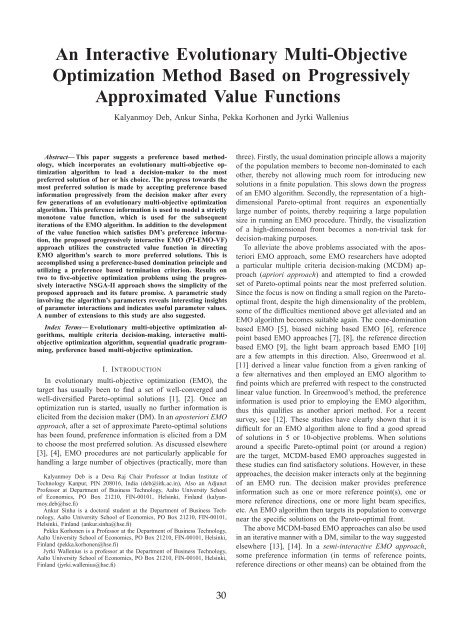Progressively Interactive Evolutionary Multi-Objective Optimization ...
Progressively Interactive Evolutionary Multi-Objective Optimization ...
Progressively Interactive Evolutionary Multi-Objective Optimization ...
You also want an ePaper? Increase the reach of your titles
YUMPU automatically turns print PDFs into web optimized ePapers that Google loves.
An <strong>Interactive</strong> <strong>Evolutionary</strong> <strong>Multi</strong>-<strong>Objective</strong><br />
<strong>Optimization</strong> Method Based on <strong>Progressively</strong><br />
Approximated Value Functions<br />
Kalyanmoy Deb, Ankur Sinha, Pekka Korhonen and Jyrki Wallenius<br />
Abstract— This paper suggests a preference based methodology,<br />
which incorporates an evolutionary multi-objective optimization<br />
algorithm to lead a decision-maker to the most<br />
preferred solution of her or his choice. The progress towards the<br />
most preferred solution is made by accepting preference based<br />
information progressively from the decision maker after every<br />
few generations of an evolutionary multi-objective optimization<br />
algorithm. This preference information is used to model a strictly<br />
monotone value function, which is used for the subsequent<br />
iterations of the EMO algorithm. In addition to the development<br />
of the value function which satisfies DM’s preference information,<br />
the proposed progressively interactive EMO (PI-EMO-VF)<br />
approach utilizes the constructed value function in directing<br />
EMO algorithm’s search to more preferred solutions. This is<br />
accomplished using a preference-based domination principle and<br />
utilizing a preference based termination criterion. Results on<br />
two to five-objective optimization problems using the progressively<br />
interactive NSGA-II approach shows the simplicity of the<br />
proposed approach and its future promise. A parametric study<br />
involving the algorithm’s parameters reveals interesting insights<br />
of parameter interactions and indicates useful parameter values.<br />
A number of extensions to this study are also suggested.<br />
Index Terms— <strong>Evolutionary</strong> multi-objective optimization algorithms,<br />
multiple criteria decision-making, interactive multiobjective<br />
optimization algorithm, sequential quadratic programming,<br />
preference based multi-objective optimization.<br />
I. INTRODUCTION<br />
In evolutionary multi-objective optimization (EMO), the<br />
target has usually been to find a set of well-converged and<br />
well-diversified Pareto-optimal solutions [1], [2]. Once an<br />
optimization run is started, usually no further information is<br />
elicited from the decision maker (DM). In an aposteriori EMO<br />
approach, after a set of approximate Pareto-optimal solutions<br />
has been found, preference information is elicited from a DM<br />
to choose the most preferred solution. As discussed elsewhere<br />
[3], [4], EMO procedures are not particularly applicable for<br />
handling a large number of objectives (practically, more than<br />
Kalyanmoy Deb is a Deva Raj Chair Professor at Indian Institute of<br />
Technology Kanpur, PIN 208016, India (deb@iitk.ac.in), Also an Adjunct<br />
Professor at Department of Business Technology, Aalto University School<br />
of Economics, PO Box 21210, FIN-00101, Helsinki, Finland (kalyanmoy.deb@hse.fi)<br />
Ankur Sinha is a doctoral student at the Department of Business Technology,<br />
Aalto University School of Economics, PO Box 21210, FIN-00101,<br />
Helsinki, Finland (ankur.sinha@hse.fi)<br />
Pekka Korhonen is a Professor at the Department of Business Technology,<br />
Aalto University School of Economics, PO Box 21210, FIN-00101, Helsinki,<br />
Finland (pekka.korhonen@hse.fi)<br />
Jyrki Wallenius is a professor at the Department of Business Technology,<br />
Aalto University School of Economics, PO Box 21210, FIN-00101, Helsinki,<br />
Finland (jyrki.wallenius@hse.fi)<br />
30<br />
three). Firstly, the usual domination principle allows a majority<br />
of the population members to become non-dominated to each<br />
other, thereby not allowing much room for introducing new<br />
solutions in a finite population. This slows down the progress<br />
of an EMO algorithm. Secondly, the representation of a highdimensional<br />
Pareto-optimal front requires an exponentially<br />
large number of points, thereby requiring a large population<br />
size in running an EMO procedure. Thirdly, the visualization<br />
of a high-dimensional front becomes a non-trivial task for<br />
decision-making purposes.<br />
To alleviate the above problems associated with the aposteriori<br />
EMO approach, some EMO researchers have adopted<br />
a particular multiple criteria decision-making (MCDM) approach<br />
(apriori approach) and attempted to find a crowded<br />
set of Pareto-optimal points near the most preferred solution.<br />
Since the focus is now on finding a small region on the Paretooptimal<br />
front, despite the high dimensionality of the problem,<br />
some of the difficulties mentioned above get alleviated and an<br />
EMO algorithm becomes suitable again. The cone-domination<br />
based EMO [5], biased niching based EMO [6], reference<br />
point based EMO approaches [7], [8], the reference direction<br />
based EMO [9], the light beam approach based EMO [10]<br />
are a few attempts in this direction. Also, Greenwood et al.<br />
[11] derived a linear value function from a given ranking of<br />
a few alternatives and then employed an EMO algorithm to<br />
find points which are preferred with respect to the constructed<br />
linear value function. In Greenwood’s method, the preference<br />
information is used prior to employing the EMO algorithm,<br />
thus this qualifies as another apriori method. For a recent<br />
survey, see [12]. These studies have clearly shown that it is<br />
difficult for an EMO algorithm alone to find a good spread<br />
of solutions in 5 or 10-objective problems. When solutions<br />
around a specific Pareto-optimal point (or around a region)<br />
are the target, MCDM-based EMO approaches suggested in<br />
these studies can find satisfactory solutions. However, in these<br />
approaches, the decision maker interacts only at the beginning<br />
of an EMO run. The decision maker provides preference<br />
information such as one or more reference point(s), one or<br />
more reference directions, one or more light beam specifics,<br />
etc. An EMO algorithm then targets its population to converge<br />
near the specific solutions on the Pareto-optimal front.<br />
The above MCDM-based EMO approaches can also be used<br />
in an iterative manner with a DM, similar to the way suggested<br />
elsewhere [13], [14]. In a semi-interactive EMO approach,<br />
some preference information (in terms of reference points,<br />
reference directions or other means) can be obtained from the
















